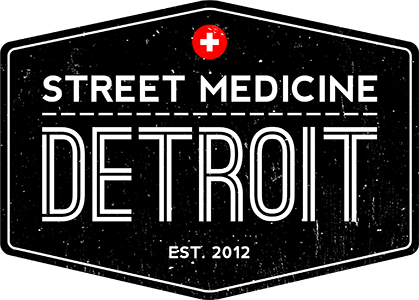As Michigan’s weather wheel turns from the bitter cold of winter to the summer’s blistering heat, Street Medicine Detroit (SMD) and our partners at Neighborhood Service Organization (NSO) see a new array of health conditions among the community. Cases of frostbite and hypothermia are replaced with heat stroke, dehydration, and heat exhaustion.
Several factors affect the body’s cooling system during the hot summers. When the humidity is high, sweat does not evaporate as quickly and will not allow the body to release heat quickly. Age, obesity, dehydration, heart disease, mental illness, poor circulation, and use of prescription drugs or alcohol are factors that affect the risk of heat-related illness. Groups such as the elderly, infants, children, people with chronic medical conditions, and people who are experiencing homelessness are also at increased risk. For those who are experiencing homelessness, extreme heat affects other aspects of life. Intolerable sleeping conditions may lead to insomnia while the inability to keep food cool may increase risk of foodborne illness.
The August 2003 heat wave that occurred in France is a famous case studied by scientists to identify risk factors for heat-related illness. It also shows how serious extreme heat can be; during this time, there were nearly 15,000 heat-related deaths, particularly among the elderly. Social factors involved in these deaths include living in an urban area, low socioeconomic status, and social isolation. Many of these individuals were living alone and had no one to check on them.
While heat-related illness is serious, it is also highly preventable. Here are some identifying signs of the three most common heat-related emergencies from the Centers for Disease Control (CDC):
Heat cramps are painful spasms of the leg or stomach muscles and may be accompanied by heavy sweating. They do not require medical attention, but the person should stop all activity and sit quietly in a cool place and drink water, juice, or a sports drink.
Heat exhaustion includes extreme fatigue, heavy sweating, thirst, headache, dizziness, fast and shallow breathing, nausea and vomiting, pale and moist skin, and a fast, weak pulse. If untreated, it may progress to heat stroke. Ways to cool off include rest in an air-conditioned environment, lightweight clothing, cool, non-alcoholic beverages, and a cold shower/bath.
Heat stroke is a life-threatening condition caused by breakdown of the body’s thermoregulation. The skin no longer sweats but becomes red, dry, and very hot. Other symptoms may include chest pain, shallowness or shortness of breath, abdominal pain, confusion, anxiety, rapid pulse, and throbbing headache. Body temperature rises to 103˚F or above. Until emergency medical care arrives, cool the person rapidly with whatever methods are available: remove extra layers of clothing, fan, and apply cool water using a wet sheet, sponge, or garden hose.
Above all else, remember that heat-related illnesses can affect anyone. Please drink plenty of fluids this summer, not just whenever you feel thirsty. Avoid alcoholic and caffeinated drinks, as they can contribute to water loss. If you or someone you know has a risk factor mentioned above, adapt a buddy system with a friend to check on each other periodically this summer. Stay cool!
Anirudha Rathnam MSII, SMD Publishing Coordinator
Originally published in Thrive:D Street Newspaper August 25, 2014
http://thrivedetroit.net/beat-the-heat-street-medicine-detroit-explains-heat-related-illness-and-how-to-cool-off/

